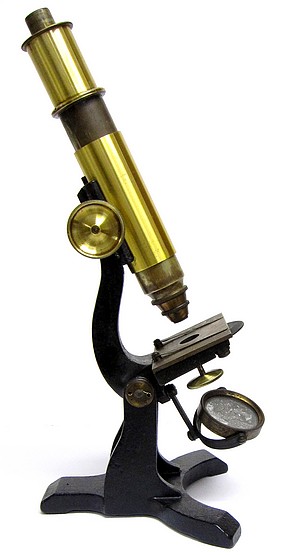
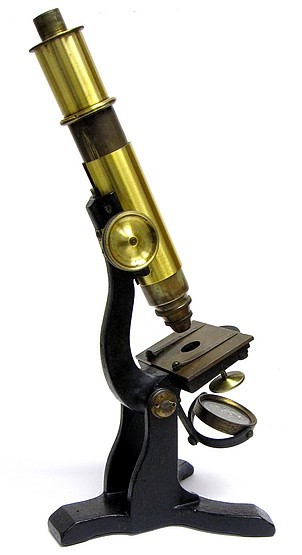
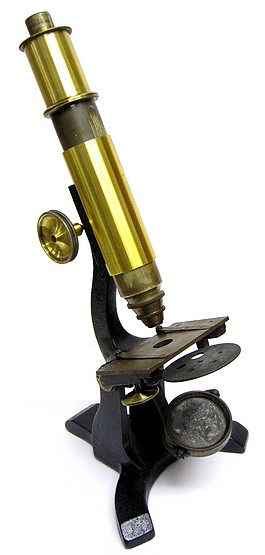
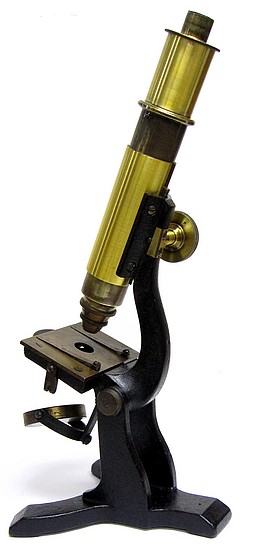
While this microscope
is unsigned by the maker, it is clearly of American
origin. The shape of the cast-iron base and limb is
characteristic of the early instruments made by J.
& W. Grunow. In fact, except for the addition of
a coarse focus by rack and pinion, this instrument
appears nearly identical to the Educational Model
shown in the 1857 Grunow catalog. The objective is
signed Queen & Co. and may not have been
originally supplied with the microscope. When
purchased for this collection, the original lacquered
brass surface finish was absent; it has subsequently
been restored.
This
microscope likely dates from the 1860's. The
Grunow brothers, Julius and William, emigrated from
Germany to New York around 1849. They started in the
scientific instrument business by first working for
the optician Benjamin Pike of that city. By 1854,
they began their own operation in New Haven CT where
they concentrated on the production of microscopes.
By 1864, they were back in New York. Some years
later, the partnership ended. J. Grunow continued on
to produce microscopes up to around 1892. The total
output of the Grunows was limited in comparison to
some other contemporary firms; on the basis of the
observed serial numbers, they manufactured just over
one thousand microscopes in total.
The following is an
extract from the Illustrated Scientific and
Descriptive Catalogue of Achromatic Microscopes, J.
& W. Grunow & Co., New Haven Conn,
1857.
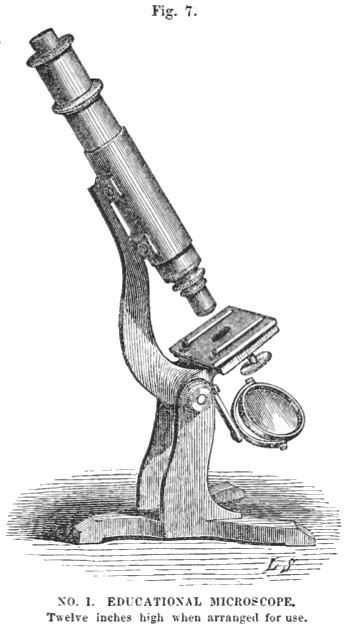
Educational
Microscope. This instrument is mounted on a
firm tripod, with up- rights of japanned cast-iron. A
solid limb of japanned cast-iron supports the stage
and the body of the instrument, and being attached to
the uprights by a trunnion joint, it allows the
instrument to be inclined at any angle. The body of
the instrument slides easily and steadily in a firm,
but elastic brass cylinder, attached to the japanned
limb, by which means it is readily adjusted to any
desired focus. The stage is two by three inches,
having spring clips to retain the object in place
when the microscope is inclined.A fine screw, with a
milled head, at the right of the stage, gives a fine
adjustment to the focus.
Below the stage is a
diaphragm plate, with orifices of different sizes to
regulate the illumination, and a space between the
largest and smallest orifices to exclude all the
light, and give a dark background for viewing opaque
objects.
A concave mirror an
inch and a half in diameter, suspended by a cradle
joint, and movable in every direction, is used for
illuminating the object.The mirror is so attached to
the axis of the instrument, by a movable arm, that it
can be turned so as to give very oblique
light.
This instrument is
generally supplied with two eye-pieces, and with one
inch and one quarter inch objectives of second
quality, giving four magnifying powers, varying from
40 to 350 diameters.
This microscope is
designed, as its name implies, for educational
purposes, for schools, private families, and for
young people generally. Farmers, mechanics and
merchants, who desire to devote some of their leisure
hours to intellectual improvement, or to the
investigation of those branches of natural science
more or less connected with their several avocations,
will find this at once a cheap, substantial and
efficient microscope.
As it is very steady
and delicate in its adjustments, and can be used with
the higher powers, the man of science will often find
it a convenient substitute for the larger
microscopes, when a more portable instrument is
required for special purposes.




